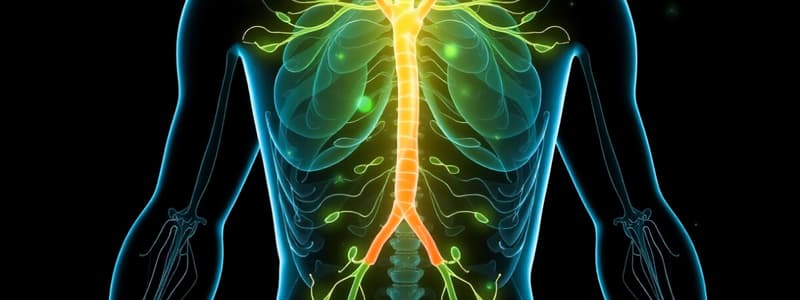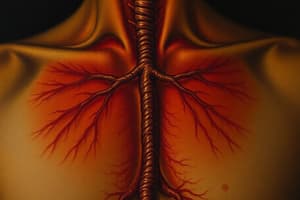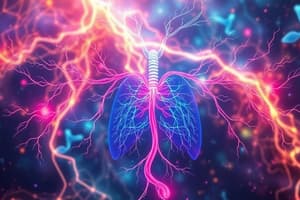Podcast
Questions and Answers
Which hormone exemplifies fast-acting responses within the endocrine system?
Which hormone exemplifies fast-acting responses within the endocrine system?
- Testosterone
- Cortisol
- Aldosterone
- Epinephrine (correct)
What is the primary function of the endocrine system?
What is the primary function of the endocrine system?
- Filtering waste products from the blood.
- Providing structural support and movement.
- Defending the body against pathogens.
- Facilitating communication between organs, tissues, and cells, and regulating biological processes. (correct)
Which of the following is an example of endocrine signaling?
Which of the following is an example of endocrine signaling?
- A hormone is produced and acts within the same cell without exiting.
- Insulin and glucagon from the pancreas acting throughout the body. (correct)
- Estrogen in the ovaries regulating the maturation of ovarian follicles.
- Signaling molecules influencing other cells within the same organ or tissue.
Which gland secretes hormones that are derived from tyrosine?
Which gland secretes hormones that are derived from tyrosine?
If a patient has a hormone imbalance that disrupts blood glucose levels, which gland is most likely involved?
If a patient has a hormone imbalance that disrupts blood glucose levels, which gland is most likely involved?
Which hormone is directly involved in regulating calcium levels in the blood?
Which hormone is directly involved in regulating calcium levels in the blood?
Which of the following best describes paracrine hormone signaling?
Which of the following best describes paracrine hormone signaling?
Which type of signaling involves a hormone acting inside the cell that produced it, without ever being secreted?
Which type of signaling involves a hormone acting inside the cell that produced it, without ever being secreted?
Which characteristic distinguishes steroid hormones from protein and peptide hormones?
Which characteristic distinguishes steroid hormones from protein and peptide hormones?
How do protein and peptide hormones typically initiate a cellular response?
How do protein and peptide hormones typically initiate a cellular response?
Which of the following is a primary mechanism by which steroid hormones exert their effects?
Which of the following is a primary mechanism by which steroid hormones exert their effects?
What is the significance of hormone binding to proteins in the blood?
What is the significance of hormone binding to proteins in the blood?
Which statement is correct regarding the transport and access of hydrophilic hormones to the brain?
Which statement is correct regarding the transport and access of hydrophilic hormones to the brain?
Which hormone does not belong to the group of protein and peptide hormones?
Which hormone does not belong to the group of protein and peptide hormones?
What role does HSP90 play in the mechanism of steroid hormone action?
What role does HSP90 play in the mechanism of steroid hormone action?
Which of the following characteristics is associated with lipophilic hormones?
Which of the following characteristics is associated with lipophilic hormones?
What distinguishes the anterior pituitary from the posterior pituitary in terms of hormone secretion?
What distinguishes the anterior pituitary from the posterior pituitary in terms of hormone secretion?
What is the function of the beta subunit in the enzyme-linked receptors used by insulin?
What is the function of the beta subunit in the enzyme-linked receptors used by insulin?
Flashcards
Function of Endocrine System
Function of Endocrine System
Regulates biological processes and maintains homeostasis.
Speed of Hormone Action
Speed of Hormone Action
Hormones can act quickly (seconds) or slowly (days).
Fast-acting Hormones
Fast-acting Hormones
Hormones like epinephrine that respond rapidly in emergencies.
Slow-acting Hormones
Slow-acting Hormones
Signup and view all the flashcards
Endocrine Signaling
Endocrine Signaling
Signup and view all the flashcards
Paracrine Signaling
Paracrine Signaling
Signup and view all the flashcards
Amino Acid Derived Hormones
Amino Acid Derived Hormones
Signup and view all the flashcards
Example of Hormones from Glands
Example of Hormones from Glands
Signup and view all the flashcards
Protein and Peptide Hormones
Protein and Peptide Hormones
Signup and view all the flashcards
Steroid Hormones
Steroid Hormones
Signup and view all the flashcards
Anterior Pituitary
Anterior Pituitary
Signup and view all the flashcards
Hydrophilic Hormones
Hydrophilic Hormones
Signup and view all the flashcards
Lipophilic Hormones
Lipophilic Hormones
Signup and view all the flashcards
Hormone Binding Proteins
Hormone Binding Proteins
Signup and view all the flashcards
Mechanism of Action of Protein Hormones
Mechanism of Action of Protein Hormones
Signup and view all the flashcards
Mechanism of Action of Steroid Hormones
Mechanism of Action of Steroid Hormones
Signup and view all the flashcards
Half-life of Hormones
Half-life of Hormones
Signup and view all the flashcards
Free Hormone
Free Hormone
Signup and view all the flashcards
Study Notes
Endocrine System Overview
- The endocrine system regulates biological processes by communicating between organs, tissues, and cells locally and distantly.
- It maintains homeostasis (e.g., temperature, blood pressure).
- It regulates reproduction.
- Hormone action speeds vary, from seconds to days.
- Fast-acting hormones (e.g., epinephrine, norepinephrine) respond rapidly to events like shock.
- Slow-acting hormones (e.g., steroid hormones) have slower responses due to their mechanism.
- Dysfunction can disrupt fundamental processes like reproduction, growth, metabolism, and homeostasis (e.g., blood pressure, glucose).
- The primary goal is to maintain homeostasis.
Endocrine Glands and Hormones
- Hypothalamus: GHRH, CRH, TRH, GNRH, somatostatin, dopamine, vasopressin, oxytocin.
- Pituitary Gland: Growth hormone, prolactin, ACTH, other hormones.
- Parathyroid Gland: Parathyroid hormone (PTH).
- Pancreas: Insulin, glucagon, somatostatin.
- Testes: Testosterone.
- Ovaries: Estrogen, progesterone.
- Adrenal Gland: Cortisol, aldosterone, androgens, epinephrine, norepinephrine.
- Thyroid Gland: T4 and T3 (T3 is more potent).
- Adipose Tissue: Leptin, adiponectin, resistin.
- GI Tract: Secretin, gastrin, CCK, motilin, etc.
- Bones: FGF 23.
Types of Hormone Signaling
- Endocrine: Hormones secreted into the blood, acting on distant targets (e.g., insulin, glucagon).
- Paracrine: Hormones affecting neighboring cells within the same tissue (e.g., estrogen in ovaries).
- Autocrine: Hormones affecting the same cell type that secreted them.
- Intracrine: Hormones acting within the same cell without entering the bloodstream.
Hormone Chemistry
- Amino Acid-Derived Hormones: Derived from amino acids, e.g., T3/T4 (tyrosine), calcitonin, catecholamines (epinephrine, norepinephrine, tyrosine), dopamine (tyrosine).
- Protein/Peptide Hormones: Larger than amino acid-derived hormones, e.g., hypothalamus-releasing/inhibiting hormones, pituitary hormones (ACTH, GH, prolactin, LH, FSH), posterior pituitary hormones (AVP, oxytocin), pancreas (insulin, glucagon, somatostatin), parathyroid hormone (PTH), adipose tissue (leptin, resistin, adiponectin), GI tract hormones.
- Steroid Hormones: Lipophilic (lipid-loving), hydrophobic (water-fearing), e.g., cortisol, aldosterone, androgens (adrenal cortex), estrogen, testosterone, progesterone (gonads), vitamin D.
Hypothalamus and Pituitary
- The hypothalamus is located at the top of the brain.
- The pituitary gland is located below the hypothalamus.
- The anterior pituitary secretes many hormones.
- The posterior pituitary secretes only vasopressin and oxytocin.
Hydrophilic vs. Lipophilic Hormones
| Feature | Hydrophilic Hormones | Lipophilic Hormones |
|---|---|---|
| Water/Lipid Affinity | Water-loving | Lipid-loving, water-fearing |
| Chemical Derivation | Amino acids, peptides, proteins | Steroid hormones |
| Storage | Stored in secretory granules | Little or no storage |
| Half-life | Short | Longer |
| Blood Transport | Circulate mainly unbound (some have binding proteins) | Circulate mainly bound to binding proteins |
| Receptor Location | Act primarily on membrane receptors | Act on ligand-regulated transcription factors inside the cell |
| Cellular Response | Fast, short-lived (non-genomic) | Predominantly genomic (DNA, RNA, protein production) |
| Oral Administration | Usually inactivated orally | Often given orally |
| Brain Access | Access via circumventricular organs (CVOs) due to the blood-brain barrier (BBB) | Can access brain across the BBB (some limitations due to specific transporters) |
Hormone Transport in the Blood
- Hormones bind to proteins in the blood.
- Binding proteins include TBG (thyroid hormones), transthyretin (thyroid hormones), CBG (cortisol), SHBG (sex steroids), DBG (vitamin D), and albumin (binds most steroids and thyroid hormones).
- Only the free form of a hormone can regulate biological processes.
Mechanism of Action (Protein/Peptide Hormones)
- Cannot cross cell membrane directly.
- Bind to cell surface receptors (e.g., enzyme-linked receptors, GPCRs).
- Initiate signaling cascades, leading to relatively fast responses.
Mechanism of Action (Steroid Hormones)
- Can diffuse across the cell membrane.
- Bind to intracellular receptors (often bound to HSP90).
- Receptor release, dimerization, and nuclear translocation.
- Binding to DNA, initiating gene expression (transcription and translation).
- Slower responses due to the genomic nature of the action.
Studying That Suits You
Use AI to generate personalized quizzes and flashcards to suit your learning preferences.




